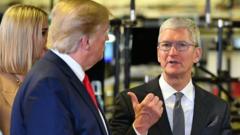Apple's significant investment aims to transition production from China to the U.S. and other countries like India and Vietnam to mitigate border taxes. CEO Tim Cook, during an investor call, indicated the company's resolve to expand U.S.-based manufacturing operations despite the complexities involved. With Apple previously pledging $500 billion in investments, this new commitment underscores its adaptation strategy amid changing global trade dynamics.
As Apple prepares to announce this investment, it is navigating a challenging landscape filled with tariffs, geopolitical relations, and economic concerns. Cook's leadership will be crucial in determining how efficiently Apple can adjust its supply chain to meet these obligations.
Apple previously managed to avoid tariffs during Trump's first term by pledging substantial investments, yet the current administration's recent tariff threats have intensified the urgency for tangible actions. Analysts remain cautious, noting that fully transitioning production capabilities domestically requires significant time and resources.
The coming months will reveal the impact of these investments on Apple's supply chain and manufacturing footprint as it strives to balance profitability with compliance amidst evolving U.S. trade policies.
As Apple prepares to announce this investment, it is navigating a challenging landscape filled with tariffs, geopolitical relations, and economic concerns. Cook's leadership will be crucial in determining how efficiently Apple can adjust its supply chain to meet these obligations.
Apple previously managed to avoid tariffs during Trump's first term by pledging substantial investments, yet the current administration's recent tariff threats have intensified the urgency for tangible actions. Analysts remain cautious, noting that fully transitioning production capabilities domestically requires significant time and resources.
The coming months will reveal the impact of these investments on Apple's supply chain and manufacturing footprint as it strives to balance profitability with compliance amidst evolving U.S. trade policies.



















